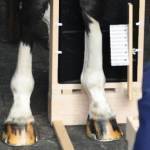High-Performance Horses: Genetics May Play a Role in Fractures

Running speed, footing, exercise intensity, and training methods have all been blamed for catastrophic injuries in athletic horses, particularly racehorses. Research shows, however, that genetics also contribute to fractures, providing new avenues to explore on the path to eliminating tragic injuries.
“Even relatively minor fractures compromise the welfare of both horse and rider, as well as the horse’s future athletic potential. Finding potential ways to minimize the incidence of fractures is essential,” noted Catherine Whitehouse, M.S., a Kentucky Equine Research nutrition advisor.
Several genes are thought to be associated with equine fractures. For example, one gene, labeled ZNF804A, is located close to the myostatin (MSTN) gene on equine chromosome 18, known as the speed gene. The block of DNA around the MSTN gene has a “major genetic effect on race distance potential and impact of workload on musculoskeletal injury risk.”
Considering this region of DNA has been highly selected for in the Thoroughbred breeding process, several research groups, including Tozaki et al. from the Genetic Analysis Department, Laboratory of Racing Chemistry in Japan, have focused on this area to find genes that could contribute to equine fractures.
In their latest endeavors*, Tozaki and colleagues analyzed four regions of DNA (called SNPs) near the MSTN gene and compared these sequences to fracture occurrence. DNA was collected from 3,706 Thoroughbred horses registered as racehorses by the Japan Racing Association in October 2002.
Results showed the following:
- Over 1,000 of the 3,706 horses (29.4%) included in the study experienced fractures during their careers;
- Over three-quarters of those fractures occurred in the forelimbs;
- Forelimb fractures most frequently occurred to the phalanx (P1, 2, and 3), metacarpal bones (cannon bones, splint bones), carpal bones (knee), and the distal radius;
- Most of the fractures (95.5%) in the carpus and distal radius were chip fractures;
- Strong associations between the four SNPs were identified with a high heritability of carpal fractures (heritability is a statistical measure of the genetic contribution to differences in phenotypes, such as fracture occurrence).
According to the researchers, this is the first study to demonstrate that carpal chip fractures may have a genetic component in Thoroughbreds. This genetic information “may contribute to the development of strategic training programs and racing plans for racehorses to improve their health and welfare.”
To maximize bone health and bone density regardless of a horse’s genetic makeup, offer Triacton. This product contains highly digestible calcium as well as an array of bone-building nutrients, including magnesium, boron, silicone, iodine, zinc, manganese, and vitamins A, C, D, and K.
“Triacton can be offered during training and competition to any athletic horse, and during times of lay-up due to injury,” said Whitehouse.
*Tozaki, T., K. Kusano, Y. Ishikawa, et al. 2020. A candidate-SNP retrospective cohort study for fracture risk in Japanese Thoroughbred racehorses. Animal Genetics 51:43-50.








